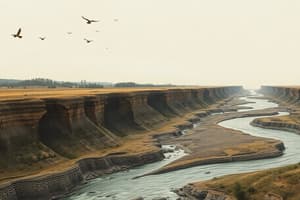Podcast
Questions and Answers
What is the primary factor that determines whether a kerogen will be oil-prone or gas-prone?
What is the primary factor that determines whether a kerogen will be oil-prone or gas-prone?
- The amount of FIGURE 2.7 incorporated into the sediments
- The preservation conditions of the organic matter
- The hydrogen content and structural makeup of the kerogen (correct)
- The type of organisms that contributed organic matter
What type of organic matter is rich in hydrogen?
What type of organic matter is rich in hydrogen?
- Starch and sugars
- Nucleic acids and cellulose
- Hydrocarbons, waxes, fats, and lipids (correct)
- Proteins and carbohydrates
What is the outcome when kerogen is unable to generate oil or gas?
What is the outcome when kerogen is unable to generate oil or gas?
- It becomes gas-prone
- It becomes oil-prone
- It disappears completely
- It becomes inert kerogen (correct)
What determines the type of hydrocarbon generated from a kerogen?
What determines the type of hydrocarbon generated from a kerogen?
What is necessary for a kerogen to be oil-prone?
What is necessary for a kerogen to be oil-prone?
What is the difference between oil-prone and gas-prone kerogen?
What is the difference between oil-prone and gas-prone kerogen?
What sedimentation rate is conducive for source rock development?
What sedimentation rate is conducive for source rock development?
What is the primary process that breaks down organic matter in sediments?
What is the primary process that breaks down organic matter in sediments?
What is the result of the transformation of biological organic matter in sediments?
What is the result of the transformation of biological organic matter in sediments?
What is the main difference between fine-grained and coarse-grained sediments?
What is the main difference between fine-grained and coarse-grained sediments?
What is the purpose of studying source rock occurrences?
What is the purpose of studying source rock occurrences?
What is the role of microbial activity in kerogen formation?
What is the role of microbial activity in kerogen formation?
What is the primary source of organic matter in fluvial systems?
What is the primary source of organic matter in fluvial systems?
What is required for sufficient amounts of organic matter to contribute to sediments and form a source rock?
What is required for sufficient amounts of organic matter to contribute to sediments and form a source rock?
What controls primary biological productivity?
What controls primary biological productivity?
What is the fate of reworked organic matter in terms of oil and gas conversion?
What is the fate of reworked organic matter in terms of oil and gas conversion?
What is the role of eolian processes in delivering organic matter to depositional environments?
What is the role of eolian processes in delivering organic matter to depositional environments?
What is the significance of autochthonous and allochthonous contributions in source rock development?
What is the significance of autochthonous and allochthonous contributions in source rock development?
What is the primary source of hydrogen-rich organic matter in sediments?
What is the primary source of hydrogen-rich organic matter in sediments?
Under what conditions is the hydrogen content of organic matter preserved in sediments?
Under what conditions is the hydrogen content of organic matter preserved in sediments?
What happens to hydrogen-rich organic matter when it is poorly preserved under oxic conditions?
What happens to hydrogen-rich organic matter when it is poorly preserved under oxic conditions?
What is the result of poor preservation of hydrogen-poor organic matter under oxic conditions?
What is the result of poor preservation of hydrogen-poor organic matter under oxic conditions?
How are oil-prone kerogens further classified?
How are oil-prone kerogens further classified?
What is the primary classification of kerogens based on?
What is the primary classification of kerogens based on?
What is one mechanism for rapidly transporting autochthonous organic matter to the seafloor?
What is one mechanism for rapidly transporting autochthonous organic matter to the seafloor?
Why is the zooplankton not a very efficient digester of phytoplankton?
Why is the zooplankton not a very efficient digester of phytoplankton?
What is a key factor in the preservation of organic matter at the sediment-water interface?
What is a key factor in the preservation of organic matter at the sediment-water interface?
What happens to organic matter at the sediment surface if the oxic/anoxic boundary is substantially below the sediment-water interface?
What happens to organic matter at the sediment surface if the oxic/anoxic boundary is substantially below the sediment-water interface?
What is 'marine snow'?
What is 'marine snow'?
What is an example of an inorganic chemical process that can degrade organic matter?
What is an example of an inorganic chemical process that can degrade organic matter?
Flashcards are hidden until you start studying




